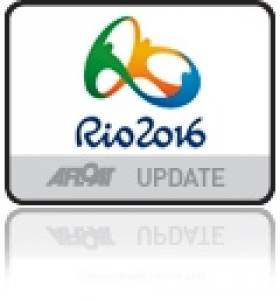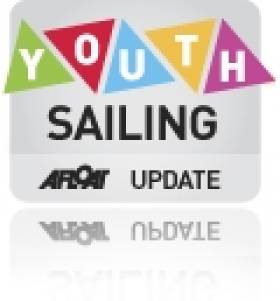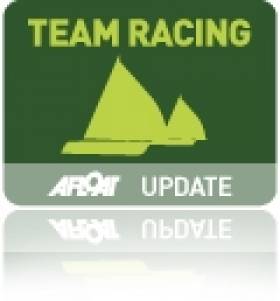Displaying items by tag: EUROSAF
Irish Sailing President Jack Roy is hosting a European Sailing Federation (EUROSAF) conference at the Royal Irish Yacht Club in Dun Laoghaire, County Dublin this weekend.
35 Race officers from 25 countries are planning the 2020 continental sailing season at the Dublin Bay venue.
Roy, who officiated at the London 2012 Olympic Games as a Race Officer, will also host a Eurosaf board meeting at the RIYC.
EUROSAF organise and sanction a series of sailing championships in Europe each year.
After a sensational win at the first Eurosaf event in Italy a week ago Dun Laoghaire's Annalise Murphy has been buoyed up by Government congratulatons sent by Minister of State for Tourism and Sport Michael Ring TD.
"Annalise was tipped from the start as favourite and demonstrated nerves of steel in mixed weather conditions to persevere and clinch the gold" Minister Ring said in praise of Afloat's Sailor of the Year. Tomorrow morning Annalise will be hoping to do it all again at the first race of Delta Lloyd regatta in Medemblik, Holland.
Although the fleet size is similar Annalise will be well aware this morning's Dutch series is very different from Lake Garda because she will be up against a higher quality field. Significantly the Dutch fleet includes at least three arch rivals from London 2012 that were not competing in Italy.
Olympic champion Lijia Xu of China is competing in the 47–boat fleet and Olympic Silver medalist Marit Boumeester is on home waters.
Britian is sending on form Alison Young, March's Palma World Cup winner and the bronze medallist from Hyeres, France.
The last time Annalise met this trio was a month ago in Hyeres when the National Yacht Club sailor struggled in the light airs of the qualifying rounds. She finished the last round of the World cup in the silver fleet, a position she will be keen not to repeat.
Forecast for the week is for light to moderate winds on the ijsselmeer which will be a good test of the 23-year-old's return to form. Certainly Annalise will need those 'nerves of steel' which the Minister of Sport has praised her for.
Second stage of the Eurosaf Champions Sailing Cup, the Delta Lloyd Regatta has taken on the challenge to bring the event to a new dimension where media presentation is playing a big part.
For Event Director, Arjen Rahusen, this is the way forward " We are concentrating our efforts to take sailing closer to the public especially through social media. All the boats will be equipped with trackers with the help of Swiss Timing. We have two video teams, who will feed daily news via the social media network and highlights. We want to give the sailors the best exposure they deserve. It is vital for them and for us!"
Racing promises to be fierce with most of the top teams engaged in all classes. Among them six 2012 Olympic and Paralympic Gold medallists will take the start on Tuesday in Medemblik.
In the 470, Matt Belcher and Will Ryan (AUS) will try to continue on their undefeated record since the start of the season. In the women division, 2012 and 2008 Gold medallists, Aleh (NZL) and Rechichi (AUS) will fight it off in a compact and talented fleet.
In the Men, expectations are high on Robert Scheidt's (BRA) return to the Lasers, however the Olympic champion will have to deal with the "down under" sailors. Tom Burton who took the title in Hyères and placed second in Palma, or Andy Maloney (NZL).
The 49ers will showcase great spectacle with strong teams from Denmark and Great Britain in the men and women divisions.
Olympic champion, Dorian van Rijsselberge (NED) and young Dutch talent Kiran Badloe are welcoming to their home event a talented fleet of windsurfers. The Polish team, French and Israeli will provide for tough competition. Moana Delle (GER), Flavia Tartaglini (ITA) or Bianca Manchon are among the favourites in the RS:X women.
In the Finn class, Hyères's winner Andrew Mills (GBR) will fight it off with PJ Postma as well as Ivan Kljakovic Gaspic (CRO) and Piotr Kula (second and third in Garda).
The new Olympic multihull, the Nacra is continuing to attract teams and countries from around the world. The Australian are now present with four boats while the earlier favourites from Holland, France or Sweden are not missing any chance to keep their lead on the fleet.
The 2.4 is represented with a large and strong fleet including British sailors Helena Lucas and Megan Pascoe (GBR), or Barend Kol (NED). Among the nine countries represented, Malaysia is participating with three sailors.
The team of Bruno Jourdren (FRA) has made a successful come back to the Sonar competition after a victory taken in Hyères. They are back in Medemblik and will face the three Sonar 2012 Paralympic medallists in a small but very strong fleet.
Sailing is scheduled from 11am on Tuesday 21st of May until Saturday 25th.
The weather for the first day of racing will be challenging going from no wind at the start of the day to strong breeze towards the end.
The Eurosaf Champions Sailing Cup is a series of five regattas in the Olympic and Paralympic Classes designed to complement the ISAF Sailing World Cup series. The Delta Lloyd Regatta (Medemblik, NED, 21-25 May) is followed by Sail for Gold Regatta (Weymouth and Portland, GBR, 9-13 June), Kiel Week (Kiel, GER, 22-26 June) and the Semaine Olympique Francaise (La Rochelle, FRA, 9-13 October).
How to follow the Delta Lloyd Regatta:
Tracking available daily for all boats on the event website.
Website; http://www.deltalloydregatta.org
NOR Announced For 2013 EUROSAF Youth Sailing Euros
#YouthSailing - The Notice of Race (NOR) for the 2013 EUROSAF Youth Sailing has now been released.
This marks the second occasion on which the combined classes continental championship of Europe has been organised – the first being in Aarhus, Denmark in August this year, hot on the heels of the successful ISAF Youth Worlds in Dublin Bay this summer.
Up to 200 sailors under the age of 19 from as many as 20 European countries will be competing for the accolade of European Youth Champion in Tavira, Portugal from 3-9 August 2013.
Medals will be available in each of eight different disciplines, including an open multihull event using the Sirena SL16 catamaran. Other designs of boats to be used are the Laser Radial, International 420 and 29er skiff. Windsurfing will be represented by the RS:X sailboard, as used at the Olympic Games. Each country is permitted to enter two crews in each of the disciplines.
Uniquely in terms of multi-event youth championships, the EUROSAF Youth Sailing European Championship includes medals races for the top sailors in each discipline.
In a development of the championship since Aarhus, there will also be a final race for competitors who do not qualify for the medal races. The results of these races will count towards the Nations Cup Team Trophy - currently held by Italy - which is awarded to the country with best overall results from the entire series across all disciplines.
Another new feature for 2013 will be an increase in the number of races for each class. This is being introduced as a direct result of recommendations from many of the coaches who were present in 2012.
The tendency these days is to have shorter races, so the athletes were often ashore and finished racing by early to mid-afternoon. In the 2013 event the windsurfers, multihull and skiffs will each have four races scheduled per day, while the single and double-handed classes will have three races scheduled. Racing starts on Monday 5 August and concludes on Friday 9 August.
The EUROSAF Youth Sailing European Championship will be hosted by Clube Náutico de Tavira, in association with the Federação Portuguesa de Vela and the European Sailing Federation. The host club previously organised the Portugal Youth Championship and the 420 Open European Championship, and will be the host of the ISAF Youth Sailing World Championship in 2014.
Tavira is located on the east side of Algarve, some 30km from the International Airport in Faro, and is one of the oldest towns of Algarve.
Marco Predieri, president of EUROSAF, said: "We are delighted to be taking this prestigious event to Portugal and Tavira, after the very successful championship in Denmark in 2012.
"EUROSAF are committed to building this championship into the foremost youth sailing championship in Europe each year, and we are confident that the 2013 hosts will help us move closer to achieving this objective."
The NOR is available to read or download HERE.
Entries Open for First 2K Team Racing Euros Next Month
#TEAM RACING - The inaugural EUROSAF Team Racing European 2 Keelboat Championships will be sailed at Lelystad in the Netherlands on 21-23 September.
Entries are invited from teams of six sailors (only four of one gender) with no weight limit. The entry fee is €380, with a €500 damage deposit.
2K team racing is a spectacular form of the sport, as it is rare, when teams are evenly balanced, for one team to get in to a commanding lead.
The team with the last boat loses, so the only safe winning position is to be first and second, with a unassailable lead over the third boat. In all other situations attack and defence continue right up to the finishing line.
Irish teams would benefit greatly from their previous team racing experience, particularly suitable for sailors who have experience of team racing but who find that the Fireflies seem to have shrunk since they were in college! On the other hand the Dutch and the Italians have been honing their skills in 2K racing for several years. All in all, this should be a fascinating event.
The Notice of Race and Entry Form are attached below, and the Irish Team Racing Association requests any team proposing to enter to contact them at [email protected].
Kieler Yacht-Club Discussion on New European Sailing Circuit
The idea was sparked off by the plans for restructuring the ISAF Sailing World Cup, which from 2013 will take place on all five continents with the result that in the long run merely one or two European events will be part of it. This calls for a European trial series. "This is necessary to have when only one event on each continent will be part of the World Cup. The worldwide time-frame will allow for only one Sailing World Cup event in Europe, so we want create a whole new series here in Europe for the athletes," say Jobst Richter, head of the Kieler Woche organizers, and Peter Ramcke, ESC project-leader from Kieler Yacht-Club, unanimously. The idea was born before this year's Kieler Woche, and since then, the initiators from Kieler Yacht-Club have been going full steam ahead to push the creation of the European Cup and find supporting partners.
Headed by the President of the European Sailing Federation (EUROSAF), Marco Predieri (Italy), this new European step was taken jointly in Kiel. A working group with representatives of EUROSAF, Kieler Woche, from Gdynia (Poland), Palma de Majorca (Spain) and Riva (Italy) has been founded to define the qualifying criteria for the European Sailing Circuit by October.
The eight participating nations with Alberto Predieri (Italy/ISAF Board Member), Alastair Fox (U.K. Event Manager), EUROSAF Vice President Dan Ibsen (Denmark, ISAF Vice President and responsible for the ISAF ranking lists) and Rafael Gonzales (Spain/Vice President and ISAF Committee Member) were unanimous: The European Sailing Circuit must be a series of attractive and already existing events, the results of which must clearly reflect in positions on the world ranking lists to offer the athletes a high sportive incentive. The event must serve as a trial series for the ISAF Sailing World Cup and provide young athletes a chance to prove themselves on a high level and qualify for the World Cup. This way, the ISAF Sailing World Cup will enter the European stage not only once a year, but will be of interest throughout the European sailing season and across a number of countries.

































































